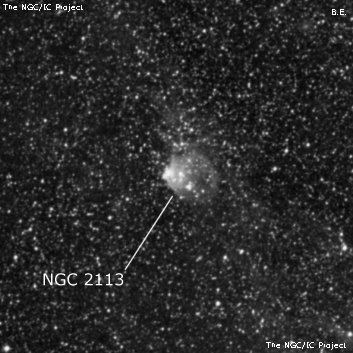
Emission nebula LHa 120-N163 lies 12' W and appeared as a bright, large, irregular glow, ~3' diameter. Several stars are involved with the nebulosity, including a mag 13 star on the north side and a couple of additional mag 13.5 stars (H-S 400). Excellent response to the NPB filter at 152x and 303x. The glow is clearly brighter in an arc (opening towards the northwest) on the southeast end.
John Herschel discovered NGC 2113 = h2975 on 3 Nov 1834 and recorded (first of 5 observations) "F (?) L, R; thick haze." The next observation was recorded as "a pB cluster nebula 90"." On a third occasion he noted "F cluster, irreg fig; gbM; 2'; resolved." The fourth observation was recorded as "F, irreg fig; resolvable; one star seen; 90"." The final observation was recorded as "irregular oval cluster; vF; 2' diameter; vl compressed to the middle; almost nebulous. Stars = 16th mag." JH noted the equivalence with Dunlop 155, although it is not given by Steinicke.
James Dunlop possibly discovered NGC 2113 = D 155? in 1826 and described "a very faint elliptical nebula, about 50" diameter, slightly bright to the center." His position is 6' SW of this cluster and the description is a reasonable match. But Wolfgang Steinicke and Glen Cozens equate D 156 with NGC 2113. The position for D 156 is 11' SE of this nebulous cluster.
600/800mm - 30" (10/13/15 - OzSky): bright, fairly large elongated glow, knotty, 1' diameter. This nebulous cluster has an unusual structure; a small bright elongated knot is on the east end (N168A) and a second small, fairly bright, elongated knot is adjacent on the west side (N168B). Strong response to an NPB filter and a much larger nebulous hazy glow extends to the west, increasing the size to 1.5'. The high surface brightness elongated pieces lie on the east end. Located 30' E of the NGC 2078/79/83/84 complex.
Notes by Steve Gottlieb